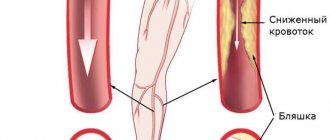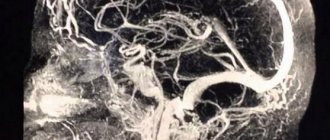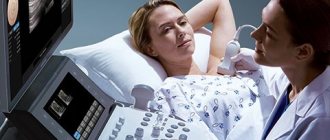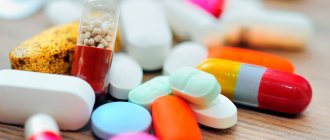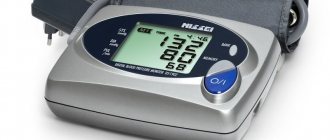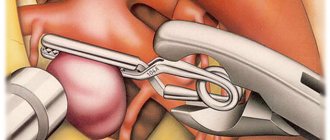Prevention
For patients prone to arterial diseases, it is important to monitor their health and adhere to the following preventive measures:
- Control of blood sugar and cholesterol;
- Compensation for diabetes mellitus (if any);
- Timely treatment of related diseases of a provoking nature;
- Normalization and stabilization of optimal body weight;
- Quitting smoking and drinking alcohol;
- Optimization of sleep and wakefulness, improvement of motor activity;
- Rationalization of nutrition and adherence to an anti-sclerotic diet (especially for older people);
- Minimizing stress effects on the body;
- Regular scheduled examinations by specialized specialists.
With minimal suspicion of arterial disease, it is important to immediately consult a doctor for differential diagnosis and adequate therapy.
Thromboangiitis obliterans (Buerger's disease)
The disease is quite rare. The course and clinical manifestations are similar to obliterating endarteritis, but differ in a more aggressive course. One of the main symptoms that distinguishes Buerger's disease from other obliterating diseases of the extremities is migrating thrombophlebitis, mainly of the superficial veins. The disease is characterized by a chronic course with periodic exacerbations and remissions.
Treatment of thromboangiitis obliterans is not much different from therapy for endarteritis obliterans. If venous thrombosis occurs, they are treated according to the general rules (see treatment of venous thrombosis).
Treatment
An important point is to eliminate etiological factors - smoking, hypothermia, etc.
Complex therapy includes antispasmodics (No-spa 2t x 3 times a day or Halidor 200 mg x 2 times a day), desensitizing drugs - for example, Claritin 1t x 1 time a day.
Otherwise, conservative therapy for the disease is practically no different from that for obliterating atherosclerosis. Course treatment should be carried out at least 2 times a year.
For obliterating endarteritis, lumbar sympathectomy is more widely used, which is currently performed using minimally invasive methods. Carrying out reconstructive operations on blood vessels, as a rule, is not possible due to diffuse damage to the arterial bed.
The possibilities of physiotherapy are wider - UHF therapy, Bernard currents, electrophoresis.
Sanatorium-resort treatment is indicated in the form of radon and hydrogen sulfide baths.
Angiography
To resolve the issue, surgical tactics require information about the patency of the arteries of the affected limb. The choice of technique for restoring blood circulation depends on the condition of the inflow pathways to the affected limb and the vascular bed below the site of blockage. In addition, angiography can distinguish embolism from thrombosis against the background of atherosclerotic narrowing. During an angiographic examination, endovascular treatment can be undertaken in the form of thrombectomy and angioplasty of the affected segments or local thrombolytic therapy can be performed.
Arterial embolism is an acute blockage of a vessel by a thrombus or other object brought from other parts of the vascular bed. Most often, vascular surgeons deal with thromboembolism from the heart cavity during a heart attack or atrial fibrillation, from the cavity of the aneurysm of the vessel overlying the blocked artery.
Consequences of acute cessation of blood flow
The sudden cessation of blood flow leads to the phenomenon of acute ischemia. The organs and tissues that are supplied by this artery lack nutrition and oxygen, so they begin to slowly die. The most specialized tissues are affected first—nervous, muscle, and finally skin. The body tries to restore blood circulation by opening additional bypass pathways for blood flow, so sometimes tissue death is stopped. But the likelihood of such an outcome is low. In any case, acute ischemia leads either to gangrene or to the development of chronic circulatory deficiency - critical ischemia.
Who is susceptible to arterial pathologies?
The risk group for arterial dysfunction includes persons of both sexes with:
- Hereditary predisposition (family history of arterial diseases);
- Disorders of metabolic processes in the body;
- Hypertension;
- Decompensated diabetes mellitus;
- Heart rhythm disorders;
- Tendency to stress and chronic fatigue syndrome;
- Increased levels of cholesterol and lipids in the blood;
- Obesity and pre-obesity;
- Addiction to fast food and other foods with a high concentration of saturated fats;
- Physical inactivity;
- Autoimmune disorders;
- Bad habits (smoking, alcohol abuse);
- Injuries associated with vascular deformation;
- Extensive intense frostbite of the extremities;
- Chronic infectious diseases that provoke thinning of the walls of blood vessels (syphilis, tuberculosis, etc.).
Elderly people are more susceptible to vascular pathologies, but in recent years there has been a tendency to increase the number of young patients with this problem.
Signs and symptoms
Symptoms of diseases of the arterial system vary depending on the location of the lesion, but generally accepted warning signs include the following:
- Headaches and syncope (fainting);
- Increased fatigue;
- Insomnia (often due to pain);
- Jumps in blood pressure (attacks of hypertension and hypotension);
- Nausea and vomiting;
- Stool disorders (with damage to the intestinal arteries);
- Intermittent claudication;
- Pain in the affected area (at rest - inclusive);
- Numbness, tingling, burning, itching in the legs;
- Paleness, cyanosis, other changes in skin tone;
- A persistent sensation of strong pulsation in the diseased vessel (rare);
- Stable coldness of the extremities;
- Darkening or blackening of the skin;
- Formation of trophic ulcers;
- Necrotic skin changes and gangrene.


